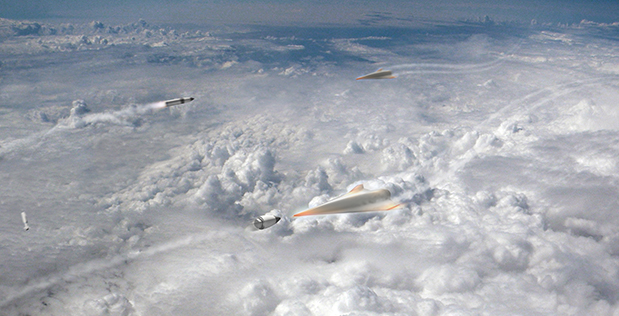by John T. Watts, Christian Trotti, and Mark J. Massa
What are hypersonic weapons?
 Hypersonic weapons are an emerging military technology that could dramatically alter the way the United States and its competitors, such as China and Russia, conduct war in the future. They are at the cutting edge of a new battle, as states seek to harness their offensive potential on the one hand, and defend against them on the other. Traveling at speeds ranging from 5 to 25 times the speed of sound, hypersonic missiles can strike targets more quickly and from farther distances than current defense postures are prepared for, thereby accelerating decision-making timelines and complicating strategic calculations.
Hypersonic weapons are an emerging military technology that could dramatically alter the way the United States and its competitors, such as China and Russia, conduct war in the future. They are at the cutting edge of a new battle, as states seek to harness their offensive potential on the one hand, and defend against them on the other. Traveling at speeds ranging from 5 to 25 times the speed of sound, hypersonic missiles can strike targets more quickly and from farther distances than current defense postures are prepared for, thereby accelerating decision-making timelines and complicating strategic calculations.
Despite this revolutionary potential, current literature on these weapons is relatively sparse. In this primer, the Atlantic Council’s Forward Defense team has situated hypersonic weapons within the geostrategic and regional context of the Indo-Pacific, providing a foundation for strategic analysis on the ways in which hypersonic weapons may shape the future of warfare, both within the region and beyond.
An emerging military technology…
While the ability of vehicles to travel at hypersonic speeds has been possible for more than half a century, the capability for reliable, sustained, and maneuverable hypersonic flight has only recently neared maturation. Motivated by the return of great-power competition and the potential asymmetric advantages provided by weapons travelling at such speeds, the United States, China, and Russia are now at the forefront of developing operational hypersonic weapons. Meanwhile, several other Indo-Pacific states are seeking to develop such capabilities in the intermediate future.
This increased attention has been accompanied by ongoing debate about the strategic and military significance of hypersonic weapons. In short, will they revolutionize warfare, or are they more of an incremental step in the evolution of missile technology? Such debates are valuable, but they are too often defined solely by technological opportunities and limitations.
In reality, it is impossible to divorce these systems from the broader contexts in which they will operate…
John T. Watts, Christian Trotti, and Mark J. Massa
An Indo-Pacific regional context…
Analysts and policymakers cannot begin to comprehend the implications of these weapons without properly situating them within broader geostrategic and regional contexts. As the common geographic locus of all three leading hypersonic nations, as well as a majority of middle powers following their lead, the increasingly volatile Indo-Pacific is the most likely region to witness the deployment and use of hypersonic weapons in the near term. However, despite the threat posed by these systems, many actors in the Indo-Pacific do not appear to have robust plans for responding to or defending against them. Greater analysis and understanding are an essential first step toward a more effective regional defense.
A foundation for strategic analysis…
In this Primer on Hypersonic Weapons in the Indo-Pacific Region, John Watts, Christian Trotti, and Mark Massa assess and synthesize the technological characteristics, regional dynamics, and geostrategic and military imperatives of hypersonic weapons, providing a foundational analysis of their development and application trajectories in the Indo-Pacific. The report covers several key facets of the current debate.
The primer begins by defining the technological characteristics and applications of the three main forms of hypersonic weapons: “boost-glide,” “airbreathing,” and “gun-launched.”
The primer then outlines the current debate over the ultimate military relevance of hypersonic weapons. Many analysts argue that the combined speed and maneuverability of these weapons compress decision-making processes and vastly increase survivability over modern air and missile defense systems, thereby embodying a “game changer.” Others are skeptical and argue that hypersonic weapons merely produce the same military effects achieved by existing capabilities, including ballistic and cruise missiles.
The primer conducts a “pulse check” of the current status of hypersonic-weapons development and strategic planning among the three great powers, as well as the United States’ allies and partners in the Indo-Pacific. The United States, China, and Russia have all tailored their hypersonic-weapons programs to achieve different strategic objectives, while priorities and perceptions among Australia, India, Japan, Singapore, South Korea, and Taiwan are mixed.
Finally, the primer analyzes the security implications of these systems for the Indo-Pacific. Chinese and Russian hypersonic weapons will likely generate greater maneuverability for “gray zone,” hybrid, and irregular activities, while holding US, allied, and partner forces at risk. This window of vulnerability could extend over the next decade.
No comments:
Post a Comment